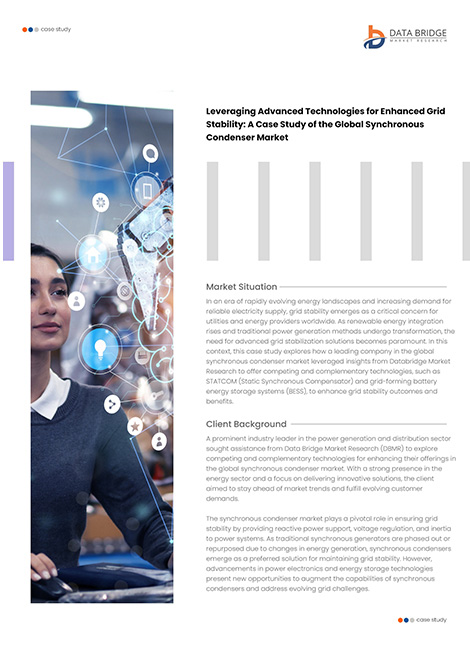Introduction
In an era of rapidly evolving energy landscapes and increasing demand for reliable electricity supply, grid stability emerges as a critical concern for utilities and energy providers worldwide. As renewable energy integration rises and traditional power generation methods undergo transformation, the need for advanced grid stabilization solutions becomes paramount. In this context, this case study explores how a leading company in the global synchronous condenser market leveraged insights from Databridge Market Research to offer competing and complementary technologies, such as STATCOM (Static Synchronous Compensator) and grid-forming battery energy storage systems (BESS), to enhance grid stability outcomes and benefits.
Client Background
A prominent industry leader in the power generation and distribution sector sought assistance from Data Bridge Market Research (DBMR) to explore competing and complementary technologies for enhancing their offerings in the global synchronous condenser market. With a strong presence in the energy sector and a focus on delivering innovative solutions, the client aimed to stay ahead of market trends and fulfill evolving customer demands.
The synchronous condenser market plays a pivotal role in ensuring grid stability by providing reactive power support, voltage regulation, and inertia to power systems. As traditional synchronous generators are phased out or repurposed due to changes in energy generation, synchronous condensers emerge as a preferred solution for maintaining grid stability. However, advancements in power electronics and energy storage technologies present new opportunities to augment the capabilities of synchronous condensers and address evolving grid challenges.
Challenges Faced by Client
- Technical Integration Complexity: Integrating competing and complementary technologies such as STATCOMs and grid-forming BESS with synchronous condensers posed technical challenges. Ensuring seamless interoperability and compatibility between different systems required rigorous testing and validation processes
- Regulatory Compliance: Adhering to regulatory requirements and standards governing grid stability solutions presented a challenge for the client. Navigating complex regulatory frameworks across different regions and ensuring compliance with grid codes and industry standards required careful attention and expertise
- Cost Considerations: Implementing advanced grid stability solutions involving multiple technologies represented a significant investment for the client. Balancing the upfront capital expenditure with long-term benefits and return on investment posed a challenge in decision-making and project planning
- Market Acceptance and Adoption: Introducing novel grid stability solutions to the market required overcoming barriers to acceptance and adoption. Educating stakeholders, including utilities, system operators, and regulatory authorities, about the benefits and feasibility of integrated solutions was essential for driving market adoption
- Interoperability Issues: Ensuring interoperability and seamless integration between different technologies and existing grid infrastructure presented a challenge. Addressing compatibility issues, interface complexities, and communication protocols required close collaboration with technology partners and stakeholders
- Performance Validation: Validating the performance and efficacy of integrated solutions in real-world grid environments posed a challenge. Conducting comprehensive field trials and pilot projects to demonstrate the reliability, effectiveness, and scalability of integrated solutions required coordination and resource allocation
- Change Management: Implementing advanced grid stability solutions involved organizational change and adaptation. Overcoming resistance to change, fostering buy-in from internal stakeholders, and aligning organizational culture with the adoption of new technologies were key challenges for the client
How DBMR Helped the Client to Overcome its Challenges?
DBMR successfully helped the clients to overcome challenges and achieve success. Below is the approach taken:
- Comprehensive Market Research: DBMR conducted in-depth market research, providing valuable insights into industry trends, technological advancements, and emerging challenges. This enabled the client to make informed decisions and identify potential technologies to enhance grid stability
- Technology Assessment: DBMR evaluated competing and complementary technologies, such as STATCOMs and grid-forming BESS, assessing their suitability and efficacy in addressing the client's grid stability requirements. This helped the client gain a deeper understanding of available options and their potential benefits
- Customized Recommendations: Based on the research findings, DBMR provided tailored recommendations for integrating STATCOMs and grid-forming BESS alongside synchronous condensers. These recommendations were aligned with the client's objectives and aimed to optimize grid stability outcomes
Business Impact
- Enhanced Grid Stability: The integration of STATCOMs and grid-forming BESS with synchronous condensers resulted in enhanced grid stability, as evidenced by improved voltage regulation, frequency control, and transient response. The combined capabilities of these technologies provided robust support for grid operation under varying load conditions and renewable energy fluctuations
- Optimized Resource Utilization: By leveraging complementary technologies alongside synchronous condensers, the company achieved optimized resource utilization and operational flexibility. STATCOMs and grid-forming BESS efficiently augmented the capabilities of synchronous condensers, enabling more efficient grid management and enhanced system reliability
- Market Leadership: Armed with insights from the DBMR research report, the client was able to position themselves as leaders in the global synchronous condenser market. Their ability to offer integrated grid stability solutions differentiated them from competitors and strengthened their market presence, driving business growth and profitability
Conclusion
This case study highlights the strategic importance of integrating competing and complementary technologies, such as STATCOMs and grid-forming BESS, with synchronous condensers to enhance grid stability and resilience. Insights from Databridge Market Research facilitated informed decision-making and enabled the leading company to recommend tailored solutions that address evolving grid challenges. Continued innovation and collaboration will be essential to advancing grid stability technologies and ensuring a reliable electricity supply in the face of changing energy landscapes.
